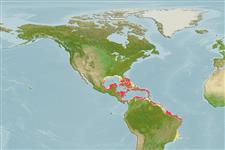Environment: milieu / climate zone / depth range / distribution range
Ökologie
seewasser riff-verbunden; tiefenbereich 1 - 73 m (Ref. 7365). Subtropical; 30°N -
Western Atlantic: Florida (USA), Bahamas, and Yucatan (Mexico) to Curaçao and probably northern South America.
Size / Gewicht / Alter
Maturity: Lm ? range ? - ? cm
Max length : 11.0 cm SL Männchen/unbestimmt; (Ref. 26938)
Rückenflossenstacheln (insgesamt) : 12; Rückenflossenweichstrahlen (insgesamt) : 8 - 9; Afterflossenstacheln: 3; Afterflossenweichstrahlen: 5. No occipital pit; two spines on part of preorbital overlapping maxillary; no supplemental preopercular spine; mushroom-like tabs on upper part of cornea present (Ref. 13608).
Inhabits primarily offshore islands and infrequently caught in continental waters (Ref. 5521). Also found in clear water over sand and turtle grass; less common around coral reefs (Ref. 26938).
Life cycle and mating behavior
Maturities | Fortpflanzung | Spawnings | Egg(s) | Fecundities | Larven
Robins, C.R. and G.C. Ray, 1986. A field guide to Atlantic coast fishes of North America. Houghton Mifflin Company, Boston, U.S.A. 354 p. (Ref. 7251)
IUCN Rote Liste Status (Ref. 130435)
Bedrohung für Menschen
Harmless
Nutzung durch Menschen
Tools
Zusatzinformationen
Download XML
Internet Quellen
Estimates based on models
Preferred temperature (Ref.
123201): 25.2 - 28, mean 27.1 °C (based on 260 cells).
Phylogenetic diversity index (Ref.
82804): PD
50 = 0.5000 [Uniqueness, from 0.5 = low to 2.0 = high].
Bayesian length-weight: a=0.01318 (0.00626 - 0.02776), b=3.03 (2.86 - 3.20), in cm total length, based on LWR estimates for this Genus-body shape (Ref.
93245).
Trophic level (Ref.
69278): 3.7 ±0.5 se; based on diet studies.
Widerstandsfähigkeit (Ref.
120179): hoch, Verdopplung der Population dauert weniger als 15 Monate. (Preliminary K or Fecundity.).
Fishing Vulnerability (Ref.
59153): Low vulnerability (10 of 100).
Nutrients (Ref.
124155): Calcium = 60.9 [23.6, 182.7] mg/100g; Iron = 0.72 [0.35, 1.81] mg/100g; Protein = 19.1 [17.4, 20.8] %; Omega3 = 0.399 [0.164, 1.137] g/100g; Selenium = 12 [5, 31] μg/100g; VitaminA = 118 [36, 402] μg/100g; Zinc = 1.11 [0.68, 1.75] mg/100g (wet weight);
